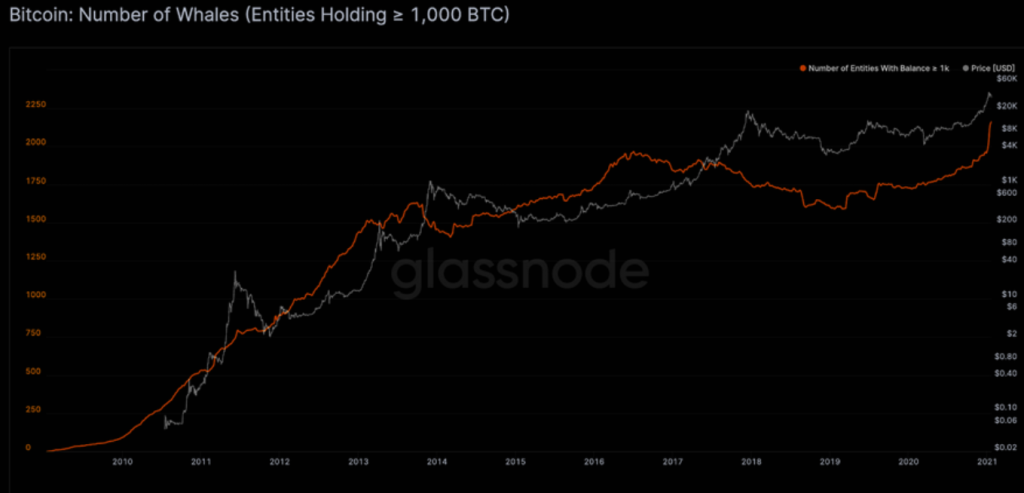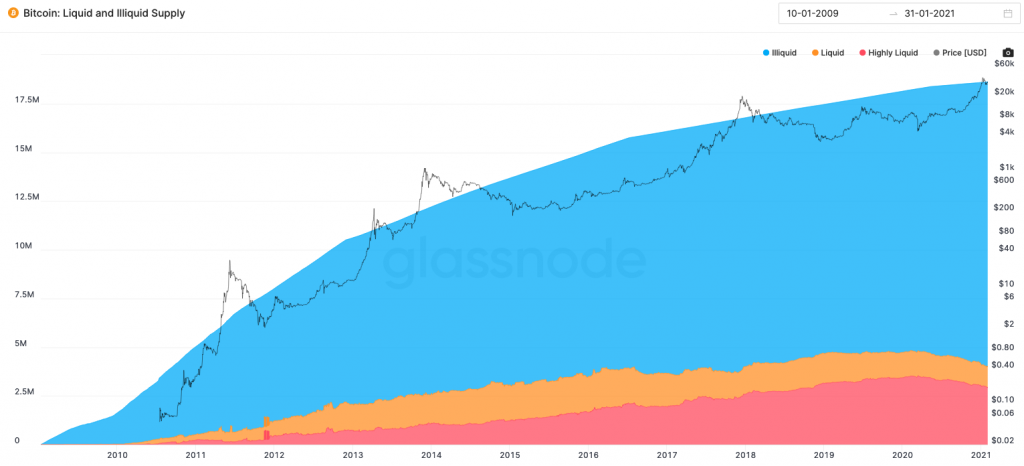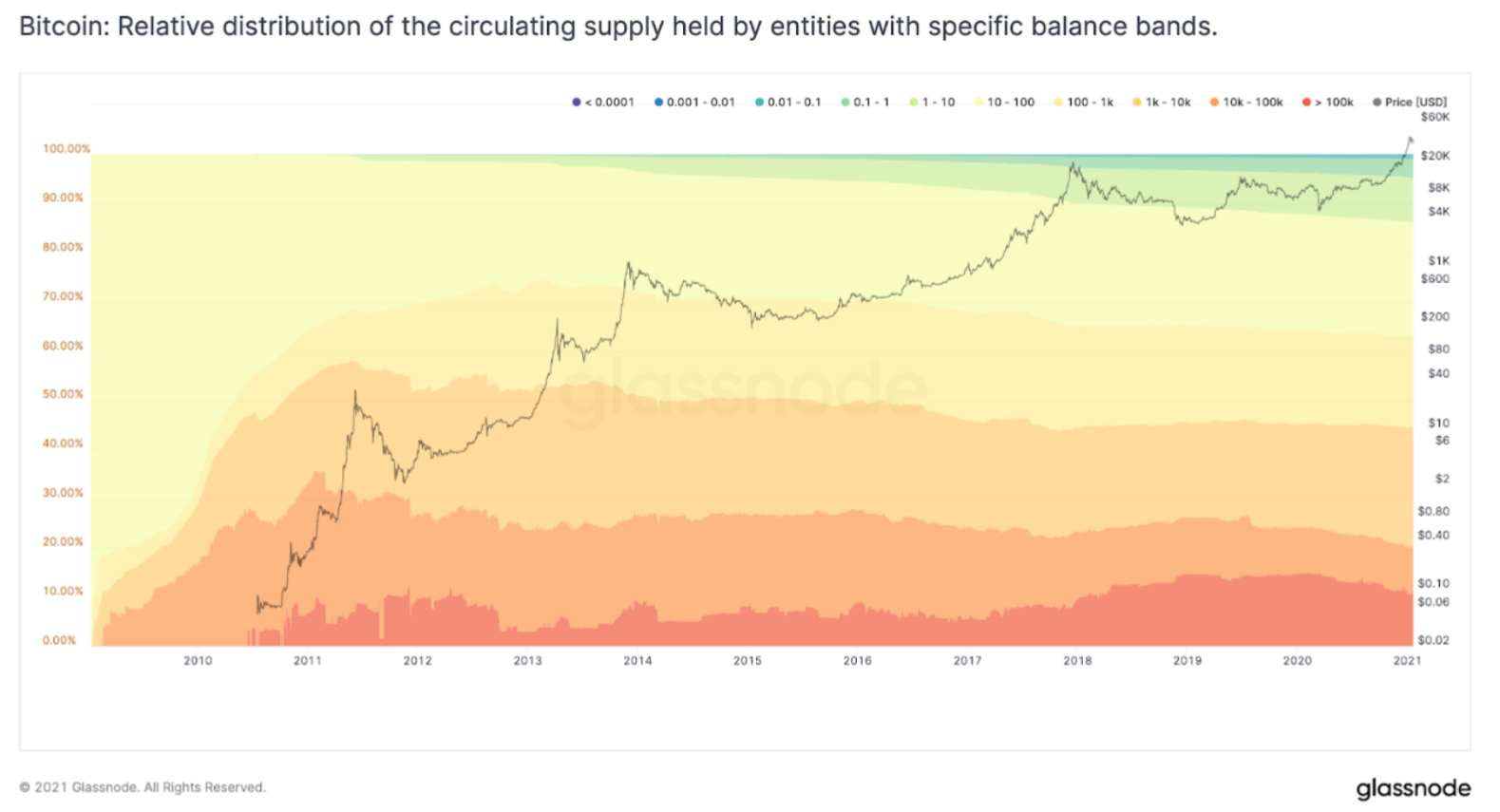
Rafael Schultze-Kraft is the co-founder and the CTO of Glassnode. He was born in Colombia but is based in Berlin now. He has an academic background in cognitive science and computational neuroscience. He got into programming, data science, machine learning, AI, and other different topics through his studies, which led him into the realm of data science. He became a data scientist, and had been working as a data scientist in the Berlin startup world for 7 years, before co-founding Glassnode.
Interview Date : 15th January 2021
- Rafael Schultze-Kraft (All Interviews)
- How did you become the co-founder of Glassnode?
- What is On-Chain Data?
- Is On-Chain Data easily accessible?
- What does the Address indication Metrics say about the market?
- Is it healthy for large entities to enter the crypto market?
- Are High-Net Worth individuals here to create speculation?
- How many Bitcoins are entities holding?
- How did you go from neuroscience to Bitcoin?
- What could be considered a warning indicator?
- Are the transfers of big transactions warning signs?
- Can we know how much businessmen and developers hold?
- How much does Satoshi hold?
- What impacts the market more than big chunky transactions?
- What do you think of the ECB’s call for “international regulation” for Bitcoin?
- Do you think Ether and BTC are fair coins?
- What is your insight page for?
Rafael Schultze-Kraft (All Interviews)
How did you become the co-founder of Glassnode?
Roughly 2,5 years ago, I met my current partners and co-founders of Glassnode who are from Switzerland and had been in the crypto industry as investors for many years. They had a need to get hands on better data in order to make better investment decisions. So, Glassnode was essentially born out of our own needs. I immediately fell in love with the idea because, as a data scientist, this was like bringing together my two favorite things in technology: data science and Bitcoin. So I was happy to join as co-founder and CTO focusing on on-chain data.
What is On-Chain Data?
I think that on-chain data is something completely new. it’s a new kind of exotic data that does not exist in traditional markets. Now we have open ledgers (blockchains) that have millions of recorded transactions. And there’s a lot of information and a lot of value in that data with respect to fundamentales and the market. From on-chain data, we can know how to time the cycles of these markets. I think this is something anyone involved in this industry would want to have an eye on. You will get a grip of what is going on under the hood, how network participants and investors are behaving.
Is On-Chain Data easily accessible?
Even though on-chain data is publicly available, it is not something that is easily accessible. Anyone can go to a public ledger and read the data, but it’s very inaccessible in its raw form. I think that is the value that Glassnode actually provides; we do the bulk work of extracting the raw data and contextualizing it in easily-to-digest metrics. Thus, people get a very easy and direct gateway to already processed and contextualized data across different digital assets, which they can use to understand the network. Users can use it to assess adoption, network activity, investor behavior, to time the market, and gauge the sentiment.
What does the Address indication Metrics say about the market?
Active addresses is a nice example of a fundamental and popular metric. From this metric, we can see how many addresses on the blockchain have been active over a certain time that have been sending or receiving BTC. So, that tells you a lot about network activity. Certainly, one active address does not mean that there is one user. As we all know, you can have one user that owns many addresses or you can have one exchange that works as the custodian of Bitcoins from many different users. But you can view this as a proxy to how many new participants are actively interacting in the network, and how that is trending. It gives you a sense of the health of the growth, and the adoption of the network. For instance, there is a clear relationship between the on-chain data and the price indicating a relation between the price and the user activity.

Is it healthy for large entities to enter the crypto market?
Industries coming into space is, in general, a very good sign, and it will have a very positive impact on industry development. This shows that this market and this new asset class has matured a lot. One of the biggest differences that we are seeing in comparison to the 2017 bull run, which was very much retail-driven, is that the current bull market is mainly driven by high-net-worth individuals, institutions, family offices, etc. And, this is positive because it shows there is infrastructure in place. This infrastructure allows these high-net-worth individuals to make whale purchases and hold their coins with custodian services. For all the other individuals that have been in the space before, this is highly appreciated. The supply is simply being absorbed, and it shows that there is a demand for smart, mature, and big money. As more and more corporations have entered, the price has risen, and I think that individuals and retail investors can be happy about this development and the adoption of the space.

Are High-Net Worth individuals here to create speculation?
I don’t think that corporations or high-net-worth individuals are here for speculative moves. Even high net-worth individuals have now understood the value of Bitcoin as a hedge against fiat and inflation. They have understood that this is an asset that is not going to go anywhere anytime soon. That’s what shows the maturity of Bitcoin. I strongly believe that these big players are here for the long run.
How many Bitcoins are entities holding?
There is 21 million Bitcoin in total. 18.6 million have already been mined and one would want to know who is holding how much, how much is actively being traded, how much is on exchanges, how much is still with miners, etc. The liquidity is found when we look at all the entities on a network-level and define a threshold by which we classify them into liquid and non-liquid depending on how much Bitcoin they are spending.

That is how we got the beautiful insight that 78% of all the supply is being held by entities that are classified as non-liquid. That means BTCs are very hard to get your hands on as they are not for sale in large amounts at this point in time. This leaves you with a smaller percentage of the circulating supply that is actually available in the market constantly changing hands. I think this adds to the scarcity and the accessibility of Bitcoin and leads them to things like reduced sell-pressure and higher demand. Because there is not enough supply, there is less liquidity on exchanges, etc., and you can understand these kinds of market dynamics through on-chain data.
How did you go from neuroscience to Bitcoin?
I started off studying computational neuroscience and cognitive science because I was interested in the big questions of life, like “Who are we” or “How does the brain work?” and “What is consciousness?”. Through computational neuroscience, I actually started to delve into the realm of data modeling. This was about creating mathematical models of neural and cognitive processes to understand the inner workings of the brain better. This is where I learned to program, as well as machine learning and intelligent data analysis. This is how my path down to data science started.. From there, I combined my passion for data with my interest in Bitcoin. This wasn’t too difficult to put together because if you apply machine learning methods and data science, the methodologies applied are the same. They are independent on whether you apply them to electrical signals in the brain, to customer data, or to on-chaine data. So, the methodology is universal and can be applied to both neuroscientific and blockchain data.
What could be considered a warning indicator?
Warning indicators could be things like old coins that have started to move. This is not necessarily always a bad thing, but it’s certainly something to keep your eyes on. This could also mean those long-term investment holders that had not traded their coins in a long time but are suddenly starting to move them on-chain now. We look at a lot of exchange movements, and how many coins are flowing to and from exchanges. Exchanges are one of the core pillars of this industry and one of the driving market forces, so it’s important to monitor how they are behaving and how many reserves they have. As we have seen in the last couple of months, there have been a lot of withdrawals. I think exchange reserves in the last year according to our data went down by 20%. That is less liquidity on the marketplaces that are available for substantial trading. This is another indicator people can look at to really determine what the current state of the market is. But it also depends on what your time horizon is, and are you an active trader, or if you rather look at the fundamentals for the long term. Also, if you want to find a nice entry point, for instance, there are a lot of indicators that help you navigate these global Bitcoin cycles. Through on-chain data metrics, we can see if we are close to the top, if it is a good time to buy, or if a bear market is starting or coming to an end, etc.

Source : Glassnode Studio
Are the transfers of big transactions warning signs?
The moving of big chunks of BTC or any valuable asset is always related to something interesting. On-chain you have to make sure you are not tracking large movements within the same entity. That’s something you cannot get from only looking at the raw on-chain data. That’s why we add a lot of intelligence layers on top of it, and do a lot of advanced clustering technology analysis. We check if large coin movements are between two distinct entities or if it is a reshuffling of funds within one exchange. An exchange can create a new cold wallet and move thousands of BTC to that, but it will look like a large whale transaction if you only look at the raw on-chain data on the blockchain. People look at this raw data move and panic, but in most cases, there is not much to get anxious about. If BTC is actually changing hands in large quantities across entities, then it’s a matter of digging deeper into it.
Can we know how much businessmen and developers hold?
We use advanced machine learning and data science pattern recognition to cluster network addresses that belong to the entities. In that way, we get much closer to the truth because now we are not looking at individual addresses but at the cluster of those that are controlled by the same entity. So, you can get a very good overview of what entities are actually holding.
How much does Satoshi hold?
We have a good assumption of how many Bitcoin Satoshi roughly has; around a million. We know that because he was the first miner who mined a lot of coins from the beginning that hasn’t moved. There is something people know as the Patoshi pattern. We were able to identify the nonce pattern of the mined blocks as being controlled by Satoshi. On May 21st, 2020, we got an alert where we saw on-chain transactions of some of the oldest Bitcoins. Those coins were from Feb 2009, so roughly a month after Bitcoin’s genesis block was created. That’s why everyone went crazy. It has been identified that the block did not have the Patoshi patterns, so it most probably was not him.
What impacts the market more than big chunky transactions?
I think market impacts are more based on human psychology and sentiment.
When people get scared thinking “what if an anonymous high-net-worth individual dumping 1 million Bitcoins?”, it is not bad to be awake and cautious, but as we go further along this path and as the number of big players in the space increases, the less impact will such movements have. For example, someone like Michael Saylor is not going to start moving his coins only because “Satoshi ” has moved 50 BTC.
What do you think of the ECB’s call for “international regulation” for Bitcoin?
I think there are a couple of things that have to address the European Central Bank. First of all, it is not surprising that the president of the ECB, Christine Lagarde, and the institution is coming out because this industry cannot be ignored. People are noticing this market, and we are reaching all-time new highs price records. It is approaching a huge market cap, so it cannot be disregarded. Today, it is not a scope of some tech-savvy nerds from a couple of years ago, but it is people from traditional finances coming in as well. So, it needs to be addressed. Amongst all this, the ECB is talking about a digital euro in a fashion that already shows how little understanding they actually have about Bitcoin. They have yet to grasp an understanding of what it is and why it is unique.
Bitcoin is decentralized in nature and it has been working for the past 12 years flawlessly. This shows that Bitcoin is not only about being digital money but about the other qualities that it has: a decentralized censorship-resistant currency that cannot change, and has a pre-programmed deflationary supply. For Christine Lagarde to argue that Bitcoin is doing “funny business”, that argument has been used for eternity which factually is not true because Bitcoin is not as private as people think. You can use on-chain data information and actually track people who are using it for scams. Plus the amount of “funny business” being done with fiat by far exceeds Bitcoin’s. Thus, her argument is invalid. Also, they pointed towards Bitcoins volatility saying “this doesn’t work as a means of transfer or as a payment method”. However, everyone already knows that being a means of payment is not Bitcoin’s primary fundamental function. It has turned from “payments technology” to “digital gold”, and now we can protect ourselves against global inflation due to fiat currency flawed systems. There is a lot of evidence showing that many politicians and people of authority don’t have a good understanding of this technology, but we cannot put private corporation owners in the same category. It is different when someone like Michael Saylor can change his mind. He is a private person who has his private business, and he saw the value of Bitcoin after many years. Conversely, the president and the party of the ECB have completely different interests in mind, so I don’t know that it would be easy for them to have a change of heart anytime soon.
Do you think Ether and BTC are fair coins?
I do think Bitcoin and Ethereum are fair coins. If you look at the distribution over time, it has become more decentralized and dispersed across different sections in the network. Besides, we cannot forget that these coins are divisible by a lot. Even if you hold a couple of Satoshi’s, their price has been appreciating. Looking at on-chain data, there is a good argument for this continuous dispersion that shows the adoption of new people coming into space. People often drop claims like “2% of all bitcoin addresses hold 95% of the supply” , but they forget to factor in things like exchanges, that today they have approximately 2.6 million BTC. When an exchange is reduced to “an address with a lot of BTC”, then you certainly will get an extremely narrow view of the whole picture. It is very clear that these 2.6 million do not belong to a dozen entities but it is millions of users that are simply holding their funds on exchanges. So, those arguments are most of the time flawed.

What is your insight page for?
Our whole insight page is one of the more needed pages created for educational purposes. I think that we are still very early in this industry in general. So, there is still a lack of understanding with respect to many of the things that are happening, especially with something more niche, like on-chain data. People still need to be taken by hand, so this educational pillar is needed to showcase how much value and insights can actually be extracted from the on-chain metrics. We collaborate on some of our on-chain articles with Willy Woo, one of the pioneers in on-chain data analytic, who is one of our partners and adds his commentary to the insights.
Interviewer , Editor : Lina Kamada
【Disclaimer】
The Article published on this our Homepage are only for the purpose of providing information. This is not intended as a solicitation for cryptocurrency trading. Also, this article is the author’s personal opinions, and this does not represent opinion for the Company BTCBOX co.,Ltd.

